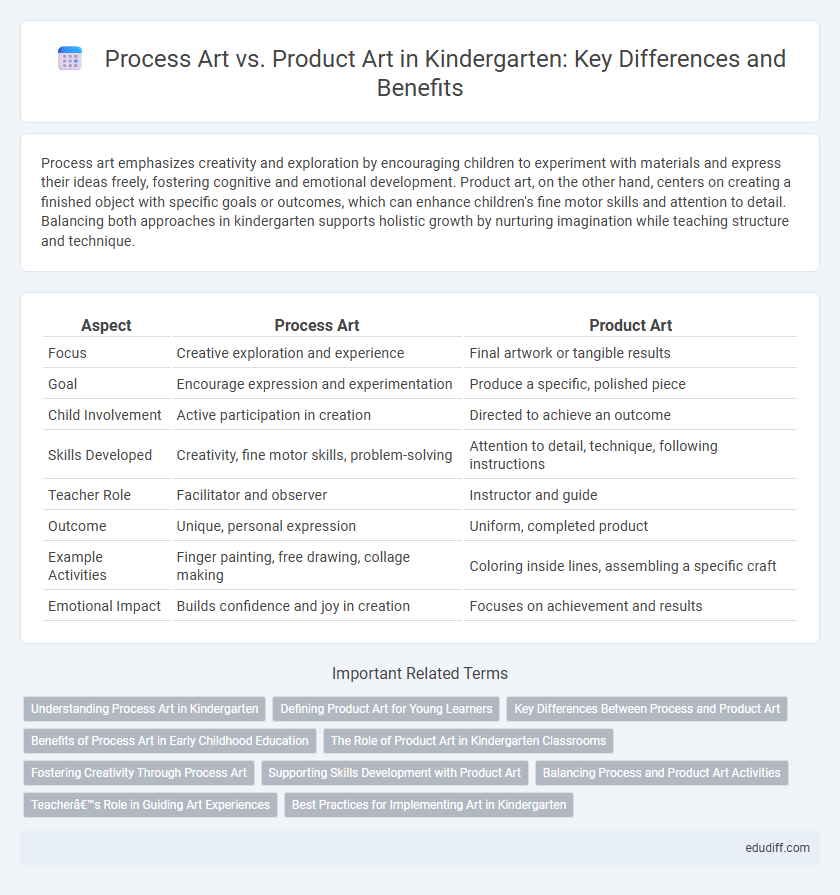Process art emphasizes creativity and exploration by encouraging children to experiment with materials and express their ideas freely, fostering cognitive and emotional development. Product art, on the other hand, centers on creating a finished object with specific goals or outcomes, which can enhance children's fine motor skills and attention to detail. Balancing both approaches in kindergarten supports holistic growth by nurturing imagination while teaching structure and technique.
Table of Comparison
| Aspect | Process Art | Product Art |
|---|---|---|
| Focus | Creative exploration and experience | Final artwork or tangible results |
| Goal | Encourage expression and experimentation | Produce a specific, polished piece |
| Child Involvement | Active participation in creation | Directed to achieve an outcome |
| Skills Developed | Creativity, fine motor skills, problem-solving | Attention to detail, technique, following instructions |
| Teacher Role | Facilitator and observer | Instructor and guide |
| Outcome | Unique, personal expression | Uniform, completed product |
| Example Activities | Finger painting, free drawing, collage making | Coloring inside lines, assembling a specific craft |
| Emotional Impact | Builds confidence and joy in creation | Focuses on achievement and results |
Understanding Process Art in Kindergarten
In kindergarten, process art emphasizes exploration and creativity, allowing children to experiment with colors, textures, and materials without a predefined outcome. This approach supports cognitive development and fine motor skills by encouraging open-ended expression and problem-solving. Understanding process art helps educators foster a supportive environment where the artistic journey takes precedence over the finished product.
Defining Product Art for Young Learners
Product art for young learners emphasizes creating a finished piece that represents a specific idea or skill, often guided by adult instructions. It helps children develop fine motor skills, understand sequencing, and learn to follow directions while producing a tangible result. This approach fosters a sense of accomplishment and introduces basic artistic concepts such as shape, color, and symmetry.
Key Differences Between Process and Product Art
Process art emphasizes exploration and creativity, valuing the child's experience and expression during art-making without focusing on the final piece. Product art prioritizes the finished artwork, often with predetermined outcomes or specific techniques guiding the creation. Key differences include the importance of creativity and experimentation in process art versus goal-oriented results and skill demonstration in product art.
Benefits of Process Art in Early Childhood Education
Process art in early childhood education emphasizes exploration and creativity, fostering children's cognitive development and fine motor skills through hands-on activities. This approach encourages self-expression and problem-solving by valuing the artistic journey over the final product, promoting emotional growth and confidence. Engaging in process art supports sensory experiences and critical thinking, crucial for foundational learning in kindergarten settings.
The Role of Product Art in Kindergarten Classrooms
Product art in kindergarten classrooms serves as a tangible reflection of children's creativity, allowing assessment of fine motor skills and cognitive development through completed artwork. Emphasizing finished pieces fosters a sense of accomplishment and pride, encouraging self-expression and boosting confidence in young learners. Displaying product art also supports classroom culture by showcasing diverse ideas and promoting community appreciation for each child's unique contributions.
Fostering Creativity Through Process Art
Process art in kindergarten emphasizes exploration, sensory experiences, and individual expression rather than focusing on the final product, allowing children to develop creativity organically. This approach encourages experimentation with materials like paint, clay, and fabric, promoting problem-solving skills and cognitive development. Educators observe each child's unique creative journey, fostering self-confidence and a deeper understanding of artistic concepts through hands-on discovery.
Supporting Skills Development with Product Art
Product art in kindergarten supports skill development by providing clear goals that encourage fine motor skills and attention to detail. Children learn to plan, execute, and evaluate their work, fostering cognitive skills like problem-solving and decision-making. This structured approach also enhances patience and perseverance as young learners work toward completing a tangible final piece.
Balancing Process and Product Art Activities
Balancing process and product art activities in kindergarten enhances children's creativity and fine motor skills while ensuring tangible results that boost confidence. Process art emphasizes exploration and self-expression through materials like paint, clay, and collage, fostering cognitive and emotional development. Incorporating product art activities allows children to experience goal-setting and accomplishment, creating a holistic learning environment.
Teacher’s Role in Guiding Art Experiences
Teachers play a crucial role in guiding art experiences by emphasizing process art, which encourages creativity, exploration, and sensory engagement over the final product. They facilitate open-ended activities, provide diverse materials, and ask reflective questions to support children's expression and cognitive development. By focusing on the artistic process, educators foster critical thinking, problem-solving skills, and emotional growth within the kindergarten environment.
Best Practices for Implementing Art in Kindergarten
Process art in kindergarten emphasizes exploration, creativity, and sensory experiences, allowing children to develop fine motor skills and self-expression without the pressure of a final product. Product art focuses on creating a tangible outcome that helps teach planning, goal-setting, and basic art techniques, supporting cognitive and visual-spatial development. Best practices include balancing both approaches to foster creativity and skill-building, using age-appropriate materials, and encouraging open-ended activities that respect each child's unique artistic journey.
Process art vs Product art Infographic

 edudiff.com
edudiff.com